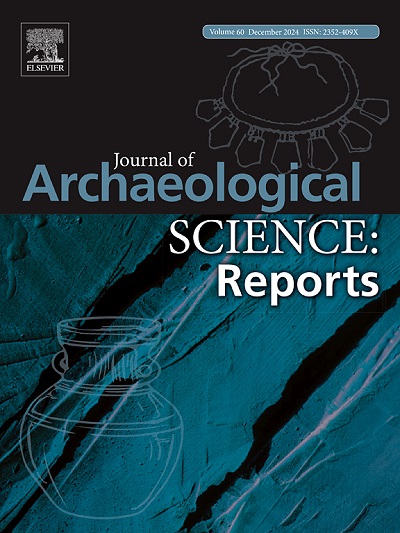Tracing the ritual fire in La Quemada (Northern Mesoamerica)
IF 1.5
2区 历史学
0 ARCHAEOLOGY
引用次数: 0
Abstract
Recent advances in absolute chronology studies on the northern border of Mesoamerica have been driven by archaeomagnetic surveys of burned artifacts. However, reliable data from the structures remain limited. La Quemada (The Burned) archaeological site is the most important regional, essentially ceremonial centre at the northern border of Mesoamerica. A series of fire pits (here referred to as LQ1 to LQ5) likely served as ceremonial torches to illuminate rituals. One hundred oriented specimens from five previously excavated fire pits were subjected to step-wise alternating field demagnetization of the natural remanent magnetization, while double-heating, Thellier absolute geomagnetic intensity experiments were performed on another 50 specimens. Magnetic mineralogy is mainly dominated by magnetite (or Ti-poor titanomagnetite) and hematite in less proporsions. The mean directions were obtained from four sites, while only one fire pit provided reliable archaeointensity values. A combination of global geomagnetic models and available regional reference curves was used for the archaeomagnetic dating. Three of the four structures yielded statistically indistinguishable intervals, indicating the La Quemada phase (650–900 CE) as the most probable period for their last exposure to fire. Absolute age estimates for the fire pit LQ1, based on various models and local paleosecular variation patterns, show strong agreement within 927–1101 CE, aligning with the last Ciudadela phase just prior to the second stage of site abandonment. For the LQ2 fire pit, the intervals obtained from models and local curves are not concordant, while no results were obtained for the fire pit LQ3. Almost similar age intervals were obtained for the LQ4 and LQ5 fire pits, 719–903 CE and 675–895 CE, respectively. A very early age was obtained for these sites using the SHA.DIF.14 k model and age corresponding to Malpaso occupational phase using the SHAWQ.2 k model. However, the local paleosecular variation curves indicate the La Quemada phase within 625–775 CE. The age interval obtained for the site LQ1 (closest fire pit to the Votive Pyramid) agrees reasonably well with the period of depopulation of the site, implying that some specific rituals persisted at the last stage of the site related to the La Quemada’s subsequent decline and abandonment, most probably due to environmental causes.
La Quemada(中美洲北部)仪式火的追踪
最近在中美洲北部边界的绝对年代学研究中取得的进展是由对烧毁的文物的考古磁调查推动的。然而,来自这些结构的可靠数据仍然有限。La Quemada (The Burned)考古遗址是最重要的区域,基本上是中美洲北部边界的仪式中心。一系列火坑(这里称为LQ1到LQ5)可能是作为仪式火炬照亮仪式。对已挖掘的5个火坑的100个定向试样进行了自然剩余磁化的阶梯式交变磁场退磁,并对另外50个试样进行了双加热、Thellier绝对地磁强度实验。磁性矿物学主要以磁铁矿(或贫钛磁铁矿)为主,赤铁矿比例较小。从四个地点获得了平均方向,而只有一个火坑提供了可靠的考古强度值。结合全球地磁模型和现有的区域参考曲线进行了古地磁测年。四个结构中的三个产生了统计上无法区分的间隔,表明La Quemada阶段(公元650-900年)最有可能是他们最后一次暴露于火中的时期。基于各种模型和当地古长期变化模式,对LQ1火坑的绝对年龄估计在927-1101 CE之间表现出强烈的一致性,与Ciudadela阶段一致,即第二阶段遗址废弃之前的最后阶段。LQ2火坑的模型区间与局部曲线区间不一致,LQ3火坑的模型区间与局部曲线区间不一致。LQ4和LQ5火坑的年龄区间基本一致,分别为719 ~ 903 CE和675 ~ 895 CE。使用SHA.DIF获得了这些站点的非常早期的年龄。使用SHAWQ.2 k模型与Malpaso职业相对应的年龄。而当地古长期变化曲线显示La Quemada期为625 ~ 775 CE。LQ1遗址(距离献祭金字塔最近的火坑)的年龄间隔与该遗址人口减少的时期相当吻合,这意味着一些特定的仪式在遗址的最后阶段持续存在,这与La Quemada随后的衰落和废弃有关,很可能是由于环境原因。
本文章由计算机程序翻译,如有差异,请以英文原文为准。
求助全文
约1分钟内获得全文
求助全文
来源期刊

Journal of Archaeological Science-Reports
ARCHAEOLOGY-
CiteScore
3.10
自引率
12.50%
发文量
405
期刊介绍:
Journal of Archaeological Science: Reports is aimed at archaeologists and scientists engaged with the application of scientific techniques and methodologies to all areas of archaeology. The journal focuses on the results of the application of scientific methods to archaeological problems and debates. It will provide a forum for reviews and scientific debate of issues in scientific archaeology and their impact in the wider subject. Journal of Archaeological Science: Reports will publish papers of excellent archaeological science, with regional or wider interest. This will include case studies, reviews and short papers where an established scientific technique sheds light on archaeological questions and debates.
 求助内容:
求助内容: 应助结果提醒方式:
应助结果提醒方式:


